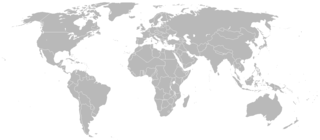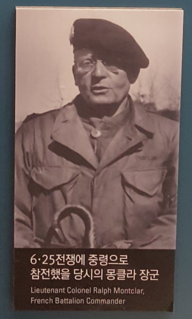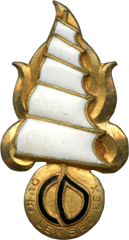Particularly following World War I, the French Foreign Legion grew exponentially reputable and important in the French Army. Accordingly, new regiments have been formed which one of them was the 1st Foreign Cavalry Regiment 1er REC.

World War I, also known as the First World War or the Great War, was a global war originating in Europe that lasted from 28 July 1914 to 11 November 1918. Contemporaneously described as "the war to end all wars", it led to the mobilisation of more than 70 million military personnel, including 60 million Europeans, making it one of the largest wars in history. It is also one of the deadliest conflicts in history, with an estimated nine million combatants and seven million civilian deaths as a direct result of the war, while resulting genocides and the 1918 influenza pandemic caused another 50 to 100 million deaths worldwide.

The Marching Regimentof the French Foreign Legion (RMLE) was a French military unit that fought in World War I and World War II. Initially composed of marching regiments from the 1st Foreign Regiment of Sidi Bel Abbes and the 2nd Foreign Infantry Regiment of Saida, Algeria, it re-formed as the 3rd Foreign Infantry Regiment.

The French Army, officially the Ground Army to distinguish it from the French Air Force, Armée de l'Air or Air Army, is the land-based and largest component of the French Armed Forces. It is responsible to the Government of France, along with the other four components of the Armed Forces. The current Chief of Staff of the French Army (CEMAT) is General Jean-Pierre Bosser, a direct subordinate of the Chief of the Defence Staff (CEMA). General Bosser is also responsible, in part, to the Ministry of the Armed Forces for organization, preparation, use of forces, as well as planning and programming, equipment and Army future acquisitions. For active service, Army units are placed under the authority of the Chief of the Defence Staff (CEMA), who is responsible to the President of France for planning for, and use, of forces.
Contents
During the interwar period and in 1930, following the creation of the 5th Foreign Infantry Regiment 5e REI in Tonkin, the Legion stood strong at 30,000 Legionnaires . Accordingly, the need to organize the Legion was necessary and also the need to provide a clear structure of command that would safe keep the evolution of the legion in relation to the foreign service of its volunteers proved to be even more important. On March 2, 1931, the general staff headquarters of the Armies, a Général, signed the instruction of two formulations, which rather initial, would be the main founding legislative pillar acts of the Inspection of the Foreign Legion.

In the context of the history of the 20th century, the interwar period was the period between the end of the First World War in November 1918 and the beginning of the Second World War in September 1939.

The 5th Foreign Infantry Regiment, surnamed Régiment du Tonkin, was a regiment of the French Foreign Legion created under the Third Republic, and dissolved in 2000. The history of this regiment is marked by the participation to World War II and the conflicts of the Indochina and Algeria.

Tonkin, also spelled Tongkin, Tonquin or Tongking, is in the Red River Delta Region of northern Vietnam.
This reorganization has been mainly and for a while preoccupied by the intentions of the Colonel Paul-Frédéric Rollet while commanding the 1st Foreign Regiment 1er RE. Since 1928, Marshal of France Louis Franchet d'Espèrey exposed in reports argumenting in favor of a new organization of the legion in reason of the increase of general enlistments and the existence of combat regiments mainly depending on two different arms, the infantry and armoured cavalry.

Paul-Frédéric Rollet (1875–1941) was a Général who led in the Marching Regiment of the Foreign Legion RMLE, and was the 1st Inspector of the Foreign Legion, a post which he created under his intentions. Rollet accumulated 41 years of military service out of which 33 were in the Legion and also planned the 100th anniversary of the legion on Cameron day of 30 April 1931. Consequently, he was responsible for creating many of the Legion's current traditions.

The 1st Foreign Regiment and the 2nd Foreign are the original and most senior founding regiments of the French Foreign Legion.

Louis Félix Marie François Franchet d'Espèrey was a French general during World War I. As commander of the large Allied army based at Salonika, he conducted the successful Macedonian campaign, which caused the collapse of the Southern Front and contributed to the armistice.
The date of creation of the Inspection of the Foreign Legion was fixed on April 1, 1931. The inspection would be entrusted to a Général (or really exceptional Colonel), particularly specialized in Legion affairs.

Général is the French word for general. There are two main categories of generals: the general officers, which are the highest-ranking commanding officers in the armed forces, and the specialist officers with flag rank, which are high-level officers in the other uniformed services.

Rank insignia in the French Army are worn on the sleeve or on shoulder marks of uniforms, and range up to the highest rank of Marshal of France, a state honour denoted with a seven-star insignia that was last conferred posthumously on Marie Pierre Koenig in 1984.
On March 26, 1931, Colonel Rollet passed command of the 1st Foreign Regiment 1er to Colonel Nicolas. On April 1, 1931, Rollet was promoted to Général de brigade and assumed the function of the Général Inspector of the Foreign Legion. Until his retirement in 1935, Rollet would serve his tailored function in total submission while comforting the culture of the Legion and codifying the essence of traditions. The inspection would be dissolved when Général Rollet would leave active duty. In 1948, the Inspection would have been seen activated for 2 years under the command of Raoul Magrin-Vernerey. Dissolved again in 1950, the inspection reappeared as Autonomous Group of the Foreign Legion (G.A.L.E) commanded successively by generals Jean Olié and Paul Gardy whom were designated as général inspector. The Autonomous Group of the Foreign Legion (G.A.L.E) compromised then, 1 Headquarters Staff in Sidi bel-Abbès, the Communal Depot of the Foreign Regiments, the 1st Foreign Infantry Regiment 1er REI which regrouped all training/instruction units and the moral service for works of the Foreign Legion (S.O.M.L.E).

The French Foreign Legion is a military service branch of the French Army established in 1831. Legionnaires are highly trained infantry soldiers and the Legion is unique in that it was, and continues to be, open to foreign recruits willing to serve in the French Armed Forces. When it was founded, the French Foreign Legion was not unique; other foreign formations existed at the time in France.

The Foreign Legion Command (official) is the Command of the French Foreign Legion. Command (COMLE) is led by a French general, a Legion officer. On another hand, command (COMLE) also includes the general staff headquarters of the foreign legion command (official), led by another senior officer, chief of the general staff headquarters of the foreign legion command (official). As of 2017, the general staff headquarters of the foreign legion command includes several divisions related to the functioning of the Legion. The general staff headquarters of the foreign legion command has adopted various inspecting, grouping, and commanding designations since 1931 and has been designated officially as C.O.M.L.E since 1984. The Général de division commanding the Legion, also known as Father of the Legion or Foreign Legion Command Chief (official) is a direct subordinate of the Chief of Staff of the French Army (C.E.M.A.T). The Division Général is also the technical counselor commanding for the ensemble related to the Legion.

Raoul Charles Magrin-Vernerey, other known as Ralph Monclar born 7 February 1892, was a French officer and 2nd Inspector of the Foreign Legion who fought in World War I, World War II within the ranks of the Free French Forces and led the French Battalion in the Korean War. He was also one of the first senior officers to respond to the Appeal of 18 June.
The inspection of the French Foreign Legion would give later form to the Foreign Legion Command.






